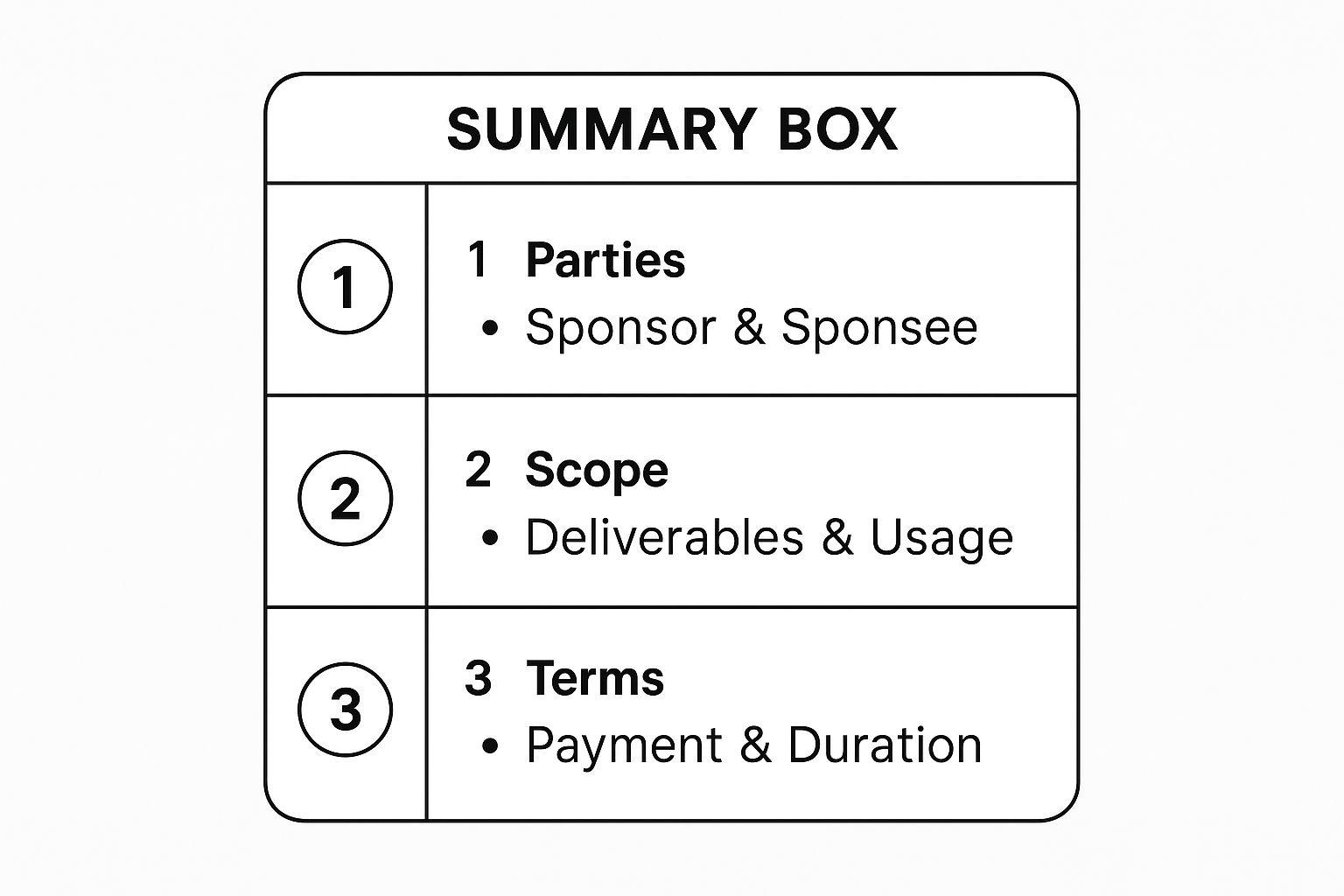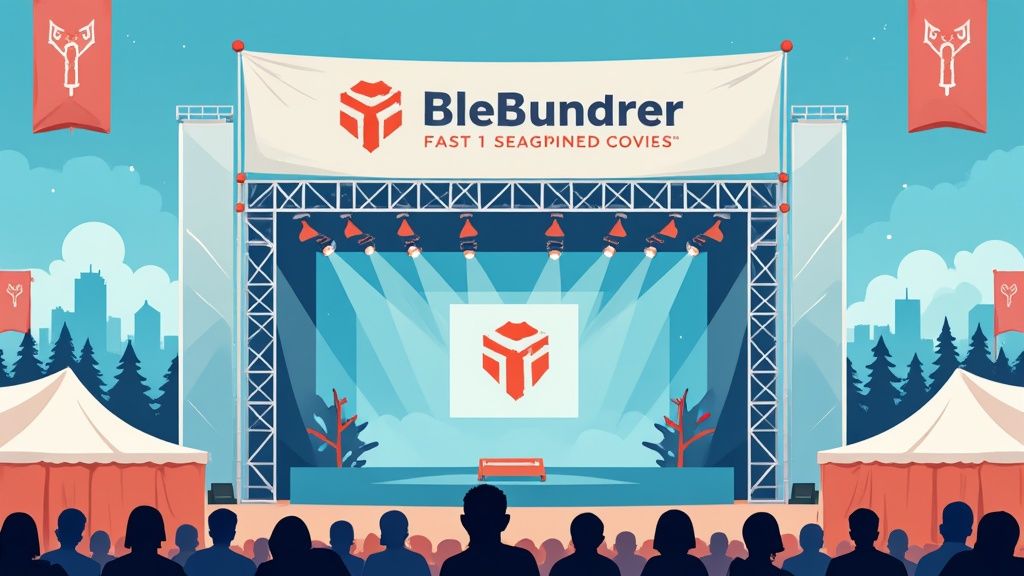
Free Sample Sponsorship Agreement Template
Published
Right, let's get you set up with a solid foundation for your next sponsorship deal. Below, you’ll find a comprehensive sample sponsorship agreement template, ready for you to download in both Word and PDF. Think of this as your professional starting point—a blueprint designed to help you build a clear, fair, and legally sound contract that protects everyone involved.
We’re about to dive deep into each clause, explaining what it means and how to tailor it to your specific needs.
Download Your Sample Sponsorship Agreement
Here are the files you need to get started. Whether you're coordinating a major event, managing an influencer brand, or representing a company, our template provides a clear, actionable framework for your partnership. If you're looking to build other types of contracts, you can find a wide variety of templates for legal documents online to help get the job done efficiently.
A quick but important note: while this template is a powerful tool, it's not a replacement for professional legal counsel. I always strongly recommend having a qualified lawyer look over your final agreement. They'll ensure it's airtight, compliant with local laws, and truly serves your best interests.
The image below gives you a bird's-eye view of the fundamental pillars of any strong sponsorship agreement.

As you can see, it all boils down to three core elements: defining the parties, outlining the scope of the partnership, and detailing the terms of engagement. Getting these right is non-negotiable.
Ready to begin? Click the links below to download the template in the format that works best for you. Keep this guide handy as you go through it; we’ll walk through every section together to ensure your partnership is built for success.
Download Now:
- Sample Sponsorship Agreement (PDF)
- Sample Sponsorship Agreement (Word)
Defining the Partnership and Scope
A solid sponsorship agreement is built on a foundation of total clarity. Before you even think about deliverables or payment schedules, you have to nail down exactly who is involved and what this partnership is all about. This first part of the contract really sets the tone for everything that follows and is your best defense against future confusion.
The very first thing to do is identify everyone involved. This means getting the full, legal names and business addresses for both the Sponsor (the company or person providing the money or goods) and the Sponsee (the individual or organization receiving the sponsorship). If you're dealing with a business, use its official registered name, like "Innovate Corp., a Delaware Corporation." If it's an influencer or individual, use their legal name.

After that, you'll typically find a "Recitals" or "Background" section. I like to think of this as the "why" of the agreement. It’s a short, simple story that outlines the context and confirms that everyone is on the same page about the partnership's goals.
Example Recital: "WHEREAS, the Sponsor markets and sells premium athletic apparel; and WHEREAS, the Sponsee organizes the Annual City Marathon, an event that perfectly aligns with the Sponsor's target audience; NOW, THEREFORE, the parties agree to the following..."
Crafting an Unambiguous Scope of Sponsorship
This clause is arguably the most important piece of the entire section. Any vagueness here is just asking for trouble down the line. You have to eliminate any and all ambiguity about what this sponsorship actually covers.
Your scope clause needs to clearly define two key things:
- The Sponsored Property: What, specifically, is being sponsored? Don't just say "the event." Is it a particular video series, a podcast season, a whole sports team? Get granular.
- The Sponsorship Level: State the official title of the partnership, like "Presenting Sponsor" or "Gold Tier Partner." This is crucial for avoiding awkward situations if there are other sponsors involved.
Since these agreements are a unique form of collaboration, it can be helpful to get a wider perspective by understanding brand partnerships in a broader sense. This context can be invaluable when structuring your scope.
For example, don't just write "Sponsorship of the 2025 Tech Conference." You need to be much more precise.
- Weak: "Sponsorship of the conference."
- Strong: "Sponsor shall be the exclusive 'Title Sponsor' of the Sponsee's 2025 Global Tech Summit, scheduled to take place from October 10-12, 2025, in New York City."
3. Structuring Payments and Financial Terms

Let's talk about the money. Getting the financial terms right is the absolute bedrock of a solid sponsorship deal. When everyone is crystal clear on who pays what, when, and how, you sidestep the misunderstandings that can sour a great partnership. This is all handled in the Sponsorship Fee clause of your agreement.
This isn’t small change we’re discussing. The global market for sponsorship rights fees hit a staggering $97.5 billion in 2024. As brands increasingly consolidate their spending on fewer, more impactful partnerships, the pressure to get these financial terms perfect has never been higher. For a deeper dive into market dynamics, these global sponsorship trends offer some fantastic context.
Common Payment Models
You've got a few ways to structure the payments, and the right choice really depends on the scope and length of your collaboration. Your main goal here is to pick a model that feels fair, aligns with the work being done, and gives both sides a sense of security.
Here are the three most common structures I see in the field:
- Lump-Sum Payment: Simple and straightforward. The sponsor pays the full fee right at the start. This is obviously great for the sponsee’s cash flow but can be a significant upfront cost for the sponsor.
- Installment Plan: This breaks the total fee into smaller, scheduled payments. A classic split is 50% when the contract is signed and the final 50% after all the work is completed.
- Milestone-Based Payments: Here, payments are tied directly to hitting specific, pre-agreed goals. For instance, a payment gets released after a set number of social media posts go live, or once the sponsored event has successfully concluded.
Pro Tip: In my experience, milestone-based payments are the fairest and most effective for long-term partnerships. It keeps the sponsor happy because they're paying for tangible progress, and it provides the sponsee with a consistent income stream as they deliver the work.
Adding Key Financial Details
Beyond just the payment schedule, you need to nail down the nitty-gritty financial details to leave no room for interpretation. Your contract has to explicitly state the payment method (like a bank transfer or check), the exact due dates for every single payment, and what happens if a payment is late.
Don't forget to clarify who’s on the hook for any relevant taxes. For creators, figuring out what to charge is the first hurdle; our guide on influencer marketing rates is a great resource to consult before you even start drafting these terms.
Outlining Deliverables and Sponsor Benefits
https://www.youtube.com/embed/puggpi-TUms
This section is the absolute core of your sponsorship agreement. It's where you stop talking in generalities and start listing, in painstaking detail, exactly what the sponsor receives for their money. If you get this part wrong, you're setting yourself up for headaches later.
Forget vague promises like "brand exposure." That means nothing and can be interpreted a dozen different ways. Your goal here is to create a crystal-clear, itemized list of every single deliverable. Think of it less as a contract clause and more as a detailed checklist for success. This clarity is what protects both you and your sponsor.
A great way to approach this is by grouping the benefits into logical categories. This not only makes the agreement cleaner and easier to read, but it also helps you think through all the different kinds of value you're actually offering.
Common Deliverable Categories
Organizing your deliverables helps everyone see the full picture at a glance. It's a simple trick that forces you to be thorough, ensuring you don't forget a key piece of the puzzle, whether it's a digital shout-out or a physical booth at an event.
Here are a few common categories you'll almost always see:
- Marketing and Promotional Rights: This is about how the sponsor can use your brand. It gives them the right to announce their association with your event or project in their own marketing materials, which is a huge part of the value for them.
- On-Site Activation: If you're running a live event, this is non-negotiable. This category spells out their physical footprint—things like booth space, signage placement, product sampling rights, or even speaking opportunities.
- Digital Media Benefits: In today's world, this is a massive piece of any sponsorship. It covers everything from dedicated social media posts and website logo placement to mentions in your email newsletters or podcast episodes.
A well-defined deliverables section is your best friend for managing expectations. For instance, instead of just saying "social media promotion," you should write something like: "four (4) dedicated Instagram posts and two (2) mentions in our weekly email newsletter to our list of 15,000 subscribers." See the difference? One is a loose promise; the other is a measurable, contractual obligation.
For every single item on your list, push yourself to be more specific. Don't just list "logo placement." Instead, define precisely where that logo will appear (e.g., website footer, event t-shirts, step-and-repeat banner), its approximate size, and its position relative to other sponsors. This level of detail is what turns a handshake deal into a professional partnership built for success.
Managing Intellectual Property and Brand Guidelines

When you enter a partnership, you're not just sharing funds or exposure; you're entrusting someone with your brand's identity. This is why the Intellectual Property (IP) Rights clause in your sponsorship agreement is so critical. It’s your primary defense for protecting what you’ve built.
This clause lays down the ground rules, granting a limited and non-exclusive license for each party to use the other's trademarks—think names, logos, and taglines. The key here is that this permission is strictly for the activities defined within the agreement. It’s all about preventing misuse and making sure every promotion reflects your brand standards.
Defining Usage and Brand Consistency
The biggest threat to your brand’s integrity in a sponsorship is ambiguity. If you don't spell out exactly how your logo can be used, you're inviting inconsistent or damaging representation that can weaken your brand's value.
The best way to eliminate that risk is by attaching a detailed set of brand usage guidelines to your agreement. This document is your brand's instruction manual.
- Logo Use: Get specific. Detail the minimum size, required clear space around the logo, and which color versions are permitted (e.g., full color, black and white).
- Prohibited Uses: Explicitly forbid any alterations. For example, a guideline might state, "The Sponsor's logo must never be stretched, skewed, or placed on a cluttered background that compromises readability."
- Approval Process: This is a non-negotiable. Always require the sponsee to submit any marketing materials featuring your IP for written approval before they go live.
Think of the IP clause as your control panel. It ensures that when a partner represents your brand, they do it with the same professionalism and consistency you've worked so hard to establish.
Ownership of Co-Created Content
It’s easy to overlook what happens to materials created together during the sponsorship—things like promotional videos, social media graphics, or co-branded event signage. If you don't define ownership from the start, you're setting yourself up for a potential dispute down the road.
Your sponsorship agreement needs to address this head-on. Typically, you'll specify that any new IP developed through the collaboration is either jointly owned or owned by one specific party, with the other getting a license for its use. Clarifying ownership upfront ensures that when the partnership ends, there’s no fighting over who gets to keep the valuable assets you created together.
Defining the Agreement's Lifespan and Exit Plan
Every sponsorship deal needs a clear beginning and end. This is handled by the "Term" clause in your sponsorship agreement template. This section sets the official start and end dates for the partnership, and getting this right is non-negotiable. Don't be vague with something like "for the duration of the event." You need to lock in specific calendar dates.
A rock-solid Term clause looks something like this: "This Agreement will begin on August 1, 2024, and remain in full force until October 31, 2024, unless terminated earlier according to the terms outlined below." This simple sentence removes any doubt about when your mutual obligations kick in and when they wrap up.
Planning for the "What Ifs": Termination Rules
Just as critical as knowing when the partnership starts is knowing how it can end. Think of the "Termination" clause as your contractual safety net. It lays out the exact circumstances under which you or your partner can legally walk away before the official end date. A smart contract always prepares for the possibility that things might not work out.
Typically, you'll see two ways a sponsorship can end early:
- Termination for Cause: This is your eject button when someone isn't holding up their end of the bargain. It's triggered by a material breach—a significant failure to deliver. This could be the event organizer not providing the promised exposure or the sponsor missing a payment. Other serious triggers often include things like bankruptcy, illegal activities, or any action that badly tarnishes a brand's reputation.
- Termination for Convenience: This clause is less common but offers an "out" for any reason at all. It usually requires one party to give the other a written heads-up, often 30 days in advance. While it provides a lot of flexibility, it also introduces a level of uncertainty that can make one or both parties nervous, so expect this point to be heavily negotiated.
Crucial Insight: A good termination clause doesn't just explain how to end the agreement; it also spells out what happens after. You need to define things like final payments, the return of any branded materials, and which responsibilities (like confidentiality) will continue even after the partnership has officially dissolved. This is what ensures a clean, professional break if it comes to that.
Including Essential Legal Protections
Most people focus on deliverables and payment schedules, and that makes sense. But the legal clauses tucked away at the end of a sample sponsorship agreement are what truly protect you when things don't go as planned. Think of them as your ultimate safety net.
These sections aren't just legal jargon; they're the unsung heroes of a solid contract. They establish a clear framework for handling the unexpected and define who is responsible when something goes wrong. Skipping over this "boilerplate" language can leave you exposed to some serious financial and legal headaches down the road.
Take the Indemnification clause. In simple terms, this specifies who foots the bill for legal costs if a third party sues one of you because of something the other partner did. It’s essentially a “hold harmless” agreement, ensuring you aren’t on the hook for your partner's mistakes.
Sample Indemnification Language: "Sponsee agrees to indemnify and hold harmless the Sponsor, its officers, and employees from any and all claims, liabilities, damages, and expenses arising from the Sponsee's negligence or willful misconduct in connection with this Agreement."
Critical Clauses for Risk Management
Indemnification is just the start. A few other key clauses are vital for keeping your partnership secure, each one addressing a specific "what if" scenario. Knowing what they are and why they matter is a fundamental part of good deal-making. For a much deeper dive into this, check out these powerful contract negotiation strategies to help you secure the best possible terms.
Here are the protections you absolutely need to include:
- Limitation of Liability: This is your financial firewall. It caps the total amount of money one party can be forced to pay the other if the contract is breached, preventing a small mistake from turning into a devastatingly expensive lawsuit.
- Confidentiality: Chances are, you'll both be sharing sensitive information. This clause creates a legal obligation for both sides to keep that information—like trade secrets or customer data—under lock and key.
- Force Majeure: What happens if a hurricane, a sudden government mandate, or another unforeseeable event makes it impossible to hold up your end of the deal? This provision addresses those "acts of God," usually allowing the agreement to be paused or ended without penalty.
- Governing Law: This seems small, but it's huge. It simply states which state's or country's laws will be used to interpret the contract. This is critical because it determines where any legal disputes would actually take place.
The stakes are higher than ever. The global sports sponsorship market alone was valued at roughly $60.17 billion in 2024 and is on track to more than double by 2033. With that kind of money flowing, you can't afford to leave your legal safeguards to chance.
Your Sponsorship Agreement Questions, Answered
As you work through a sponsorship agreement, it's totally normal for questions to come up. In fact, most people run into the same handful of queries. This section is designed to tackle those common sticking points head-on, giving you clear, straightforward answers so you can finalize your contract with confidence.
Let's start with a really fundamental one: understanding the key players. What’s the real difference between a sponsor and a donor?
A sponsor is essentially a business partner. They provide money, products, or services in exchange for something of commercial value—think advertising space, brand visibility, or access to a new audience. It's a business deal, pure and simple. A donor, on the other hand, is giving a gift out of generosity, with no strings attached and no expectation of a commercial payback.
Navigating Legal and Financial Hurdles
One of the most frequent questions I hear is about lawyers. Do you really need a lawyer to look over your sponsorship agreement?
Yes, I always recommend it. A solid template gives you a fantastic starting point, but it's not a substitute for professional legal advice. A qualified lawyer can tailor the contract to your specific needs, making sure it’s enforceable where you live and truly protects your interests. Think of it as a small investment for some serious peace of mind.
Another common concern is all about results. How do you actually measure the ROI of a sponsorship?
Tracking ROI comes down to connecting the dots between your initial goals and tangible metrics. You aren't just guessing; you're measuring.
- Figure out the media value you gained from brand mentions and exposure.
- Use special URLs or discount codes to track how many leads or sales came directly from the sponsorship.
- Run brand lift surveys before and after the campaign to see if people’s perception of your brand has changed.
- Dig into your analytics to attribute sales directly to the sponsorship activities.
When it comes to the numbers, creators often wonder what to charge. Getting a handle on industry rates is a smart first step. Taking a look at guides on how much influencers charge can give you the benchmarks you need to walk into a negotiation feeling prepared.
Finally, what’s the plan if the sponsored event gets canceled? This is a big one, and it absolutely needs to be covered in your agreement’s Force Majeure or Termination clause. A well-written contract will spell out exactly what happens—maybe a partial refund of the sponsorship fee, a credit for a future event, or some other agreed-upon solution. Defining this upfront is critical for preventing messy disputes down the road.
Ready to find your next role in the fast-paced world of brand partnerships? Influencer Marketing Jobs is the premier job board for connecting talented professionals with top opportunities in digital and influencer marketing. Explore hundreds of full-time, part-time, and remote roles to find your perfect fit. Start your search today!